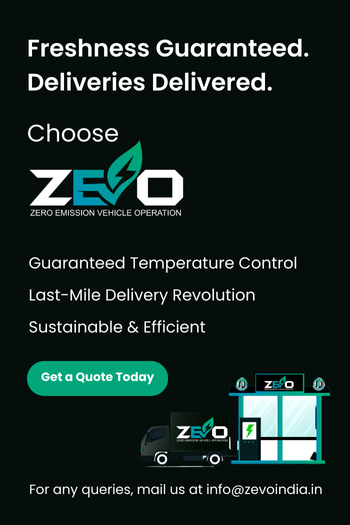Why Your Cold Delivery Costs So Much: A Breakdown for Everyone

Akshay Sharma
CEO's Office @ZEVO
Alright, logistics professionals and business leaders! Let’s face it, we’ve all experienced price shock from delivery quotes on temperature-controlled goods. Having spent some time navigating the complexities of cold chain logistics myself, I wanted to understand the reasoning behind this cost increase.
What exactly drives up the delivery cost when items require a chilled environment? It goes beyond simply keeping ice cream frozen. We’re talking about various factors that impact everyone involved in the cold chain, from optimizing delivery routes to the types of vehicles used.
This blog post will unpack the reasons behind those seemingly high refrigerated last-mile delivery costs. Whether you’re a seasoned logistics professional, an entrepreneur exploring the delivery market, or a business owner aiming to control your cold chain expenses, this information is valuable.
Deep dive into gain valuable knowledge that can help us all navigate the world of chilled deliveries more efficiently (and hopefully, more cost-effectively).
Who Feels the Freeze? Understanding Cold Chain Cost Factors
Alright, so we’ve all been there. You hit “order” on those groceries, feeling pretty good about skipping the crowded supermarket. Then, WHAM! The delivery fee skyrockets because half your cart needs to stay nice and chilled.
Frustrating, right? But listen up, there’s a reason for that price hike.
Now, I’m not saying I have a Ph.D. in logistics (although navigating online deliveries these days feels like a whole new degree!), but I’ve been around the block (or should I say, the warehouse) enough to understand the challenges. The truth is, these rising costs for cold deliveries affect everyone in the supply chain, each with their own unique pain points.
For the Everyday Shopper: You might be feeling the pinch of unpredictable delivery fees, the constant worry about something spoiling in transit, or limited delivery windows that clash with your crazy schedule. Sound familiar?
For Business Owners (like Restaurant Folks and Pharmacies): Keeping your products fresh and perfectly chilled is crucial, but those high operational costs for cold delivery can eat into your profits. Plus, there’s the constant pressure to maintain those specific temperatures during transport. And let’s not forget the juggling act of managing complex delivery schedules while keeping everything on budget. Been there, done that, right?
For Logistics Professionals (the Real Heroes): You’re the masterminds behind the smooth flow of goods, and optimizing cold chain deliveries is your daily battle. It’s a constant balancing act: ensuring speedy delivery without compromising product quality, maintaining compliance with regulations, and managing complex schedules with limited resources. We all appreciate the behind-the-scenes magic you guys work!
By understanding these different perspectives, we can all approach the world of cold chain deliveries with a little more clarity. So, buckle up, grab a cold beverage (from your fridge for now, delivery insights are coming!), and let’s unpack the reasons why those delivery fees seem to love the cold weather.
Why the Price Ices Over: Unveiling Refrigerated Last-Mile Delivery Costs
Alright, let’s get down to the nitty-gritty. We all know those delivery fees for cold stuff can be a real buzzkill, but what exactly drives up the cost? It’s not just about keeping your groceries chilly, there’s a whole iceberg of factors lurking beneath the surface.
Distance Matters: The Long Haul = Higher Fuel Costs
Think about it like running errands on a scorching summer day. The longer you’re out, the more gas you burn. The same goes for cold deliveries. If your groceries have to travel a long distance from the warehouse to your doorstep, that means more fuel is used by the delivery truck. The farther the journey, the bigger the fuel bill, which gets reflected in the final delivery fee.
Vehicle Type Makes a Difference: Fancy Freezers vs. Regular Trucks
Not all delivery trucks are created equal. Regular delivery vehicles are like regular fans – they can keep things cool-ish, but not ideal for super sensitive items. For cold deliveries, special refrigerated vans are needed. These are basically giant freezers on wheels, with powerful cooling units to maintain specific temperatures. Just like running a powerful AC at home costs more than a small fan, operating these refrigerated vans adds to the overall delivery cost.
Keeping it Precise: Temperature Matters, and Monitoring Costs
Here’s the thing: not all cold items are created equal either. Ice cream needs to be way colder than, say, orange juice. To ensure each item stays perfectly chilled throughout the journey, these refrigerated vans require constant monitoring and adjustments to maintain the specific temperature requirements. This adds complexity to the delivery process, and complexity often translates to higher costs.
Tech Keeps it Cool (Literally): The Price of Staying Frosty
Technology plays a big role in modern cold chain deliveries. We’re talking fancy gadgets like temperature sensors that keep a constant eye on how cold things are inside the truck. There’s also real-time tracking that allows everyone to see exactly where your groceries are and at what temperature. Sure, this cool tech (pun intended) helps ensure your ice cream arrives rock-solid, but it also comes with a price tag that gets factored into the final delivery fee.
Real-World Examples: Feeling the Chill of Cold Delivery Costs
Alright, so we’ve unpacked the reasons why cold deliveries can hit your wallet harder than a regular delivery. But let’s take a look at how these factors play out in the real world:
Example 1: The Long and Winding Road
Imagine you live out in a quiet suburb, miles away from the bustling city center. When you order groceries that need to stay chilled, the delivery truck has a much longer journey compared to someone living downtown. Remember that “distance matters” factor? The longer the truck is on the road, the more fuel it burns, which translates to higher costs for the delivery company. Those extra miles ultimately get reflected in the final delivery fee you see at checkout.
Example 2: The Freezer on Wheels
Let’s say you’re having a pizza party and decide to stock up on frozen pizzas online. To ensure those pizzas arrive rock-solid and ready to bake, the delivery company might need to send a special refrigerated truck. Think back to the “vehicle type makes a difference” point. These specialized freezer trucks are like luxury cars for cold deliveries, way more expensive to operate than a regular delivery van. Since running this fancy freezer on wheels costs more, the delivery fee for your pizza haul will likely be higher than, say, a delivery of non-perishable goods.
These are just a couple of examples, but they highlight how the factors we discussed earlier can significantly impact the final cost of your cold delivery. The next time you see a seemingly high delivery fee for chilled items, remember the icy path your groceries take to get to your doorstep – the distance traveled, the type of vehicle used, and the technology keeping everything perfectly chilled all contribute to the final price tag.
Beyond the Freeze: Looking at the Bigger Picture of Cold Chain Deliveries
So far, we’ve focused on the factors that make your wallet feel the frostbite of cold delivery fees. But there’s a bigger picture to consider here.
Environment Matters: Keeping it Cool, But Not at the Cost of the Planet
Those trusty refrigerated trucks that keep your groceries frosty also contribute to emissions. As more and more people rely on cold deliveries, the environmental impact becomes a growing concern. The good news is, companies are actively exploring eco-friendly solutions. Imagine electric vehicles taking over the cold delivery scene, buzzing silently with zero emissions! Additionally, optimizing delivery routes to reduce mileage and fuel consumption is another way companies are striving to keep things cool for the planet.
Future Frosts Ahead: A Glimpse into a Cooler (and More Efficient) Delivery World
Technology is constantly evolving, and the world of cold chain deliveries is no exception. The future might hold some pretty frosty (and exciting!) innovations. Imagine a world where drones whiz through the skies, delivering your ice cream in record time for short distances. Talk about convenience! Automation in warehouses could also revolutionize the game, streamlining processes and potentially reducing costs associated with cold deliveries.
While these futuristic solutions might not be mainstream yet, they offer a glimpse into a future where cold deliveries are not only efficient and affordable but also environmentally friendly. Pretty cool, right?
The Takeaway: Decoding Cold Delivery Fees
So next time you see a delivery fee for refrigerated goods, take a deep breath and remember – it’s not just about keeping your groceries cold! There’s a whole intricate dance happening behind the scenes to ensure your ice cream arrives rock-solid and your medicine stays perfectly chilled.
From the distance traveled by the delivery truck to the fancy freezers on wheels keeping everything frosty, several factors contribute to the final cost. By understanding these factors, you gain a newfound appreciation for the complexities of cold chain logistics. These companies put a lot of effort into ensuring your temperature-sensitive items arrive fresh and ready to use.
Think of this blog post as your key to unlocking the mysteries of cold delivery fees. Now, you can navigate the world of chilled deliveries with a bit more knowledge (and hopefully, a touch more understanding) about the reasons behind those seemingly high costs.

Share this Article
Subscribe to our newsletter
Be the first to receive exclusive offers and the latest news on our products and services directly in your inbox.
